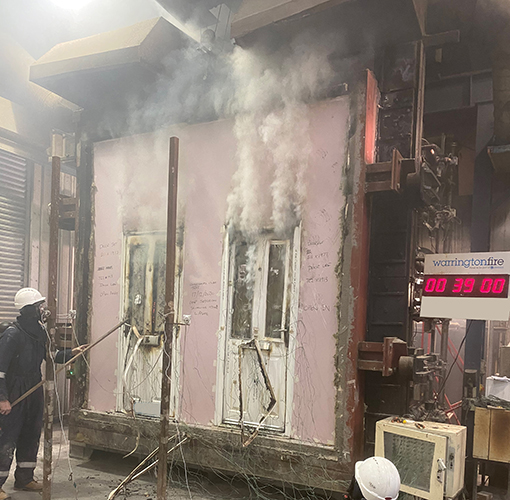Testing & Classification of Composite
Fire-Resistant Doorsets
Building Regulation guidance in the UK allows fire-resistant doorsets to demonstrate performance by either British or European Standards. However, following the introduction of the Construction Products Regulations (CPR) on 1st July 2013 and following the UKs exit from the EU all external doorsets must be either CE marked [1] or UKCA marked in accordance with:
EN 14351-1:2006+A2:2016 – Windows and doors. Product standard, performance characteristics. Windows and external pedestrian doorsets and following the end of the co-existence period of ‘EN 16034:2014 – Pedestrian doorsets[2], industrial, commercial, garage doors and openable windows — Product standard, performance characteristics — Fire resisting and/or smoke control characteristics’
on 30th November 2019, all external fire-resisting doorsets must have a Declaration of Performance and be CE or UKCA marked in accordance with the CPR. This requirement to comply with the CPR means that all testing and classification must be carried out using the relevant European test and classification standards.
It must be noted that although product standard, ‘EN 14351-2:2018 – Windows and doors – Product standard, performance characteristics. Part 2: Internal pedestrian doorsets’ has been published it has not been cited in the Official Journal of the European Union (OJEU) and has not become a Designated Standard in the UK and therefore this standard cannot be used to CE or UKCA mark internal doorsets and therefore the requirements of the CPR do not apply to internal doorsets. This means that any fire-resistant flat entrance doorset that opens onto a corridor, lobby or staircase is classed as an internal doorset[3] and cannot be CE marked.
[1] The UKs recognition of CE marking ends 1st January 2022 and all products subject to the CPR from that date must bear the UKCA mark.
[2] In accordance with EN 14351-1, an External doorsets is defined as ‘doorset which separates the internal climate from the external climate of a construction for which the main intended use is the passage of pedestrians. External pedestrian door assemblies fulfilling the provisions of this European Standard under the responsibility of one identified manufacturer are
considered to be external pedestrian doorsets
[3] In accordance with EN 14351-1, an Internal doorset is defined as ‘construction product which is designed and used to close a permanent opening in internal separating elements and for which the main intended use is the access of pedestrians (e.g. entry doors into flats or into offices and fulfilling the provision above should be considered as an internal pedestrian doorset)
It must be noted that all external fire-resisting doorsets, according to EN 16034:2014, have an Attestation and Verification of Constancy of Performance (AVCP) level of System 1. AVCP System 1 requires the Essential Characteristics (ECs) to be tested to the appropriate European Standard shown in Annex ZA of EN 16034 by a Notified Body (NB)[1] or Approved Body (AB)[2] and those products with one or more EC designated as AVCP System 1 in Annex ZA, must be certified by a Notified Product Certification Body in Europe or an Approved Body in the UK. It should be noted that certification in compliance with the requirements of the CPR AVCP System 1 is not the same as the certification schemes being introduced for composite doorsets in the UK, the UK schemes are far more onerous than that required by CPR AVCP System 1.
Following testing of a doorset to the relevant British Standards BS 476-22 and BS 476-31.1, the classification of the doorsets is determined directly from the results obtained without reference to a separate classification standard. Classifications take the form of:
FD (minutes e.g. 30, 60, etc,) – e.g. FD 30 and if smoke control is required by the addition of S, e.g. FD 30 S
Following testing of a doorset to the relevant European Standards EN 1634-1 and EN 1634-3, the classification of the doorsets is determined by reference to EN 13501-2:2016 – Fire classification of construction products and building elements – Part 2: Classification using data from fire resistance tests, excluding ventilation service. The classification of fire-resistant doorsets may be based on three types of performance:
- ‘E’ – Integrity – The ability of the doorset to withstand exposure to fire without transmission of fire to the unexposed side as a result of passage of fire or hot gases. Integrity only classifications take the form of ‘E XX’.
- ‘I’ – Thermal insulation – The mean temperature rise on the unexposed face of the door leaf shall be limited to 140°C above the initial mean temperature, the maximum temperature rise at any point of the door leaf limited to 180°C.
- There are two options of thermal insulation of doorsets that shall be used:
- ‘I¹’ – In addition to the basic requirement above, no temperature measurements shall be taken into account on the door leaf within 25mm from the border line of the visible part of the door leaf. The temperature rise of any point on the frame shall be limited to 180°C, measured at 100mm from the visible edge (on the unexposed face) of the door leaf, if the frame is wider than 100mm, otherwise it shall be measured with the centre of the disc 20mm from the junction between the frame and supporting construction. These classifications take the form of ‘EI1 XX’.
- ‘I²’ – In addition to the basic requirement above, no temperature measurements shall be taken into account on the door leaf within 100mm from the border line of the visible part of the door leaf. The maximum temperature of any point on the frame shall be limited to 360°C, measured at 100mm from the visible edge (on the unexposed face) of the door leaf, if the frame is wider than 100mm, otherwise it shall be measured at the frame/supporting boundary. These classifications take the form of ‘EI2 XX’.
- ‘W’ – Radiation[6] – Classification for radiation shall be given by the time for which the maximum value of radiation, measured as specified in the test standard, does not exceed 15 kW/m2. These classifications take the form of ‘EW XX’.
[1] The UKs recognition of CE marking ends 1st January 2022 and all products subject to the CPR from that date must bear the UKCA mark.
[2] In accordance with EN 14351-1, an External doorsets is defined as ‘doorset which separates the internal climate from the external climate of a construction for which the main intended use is the passage of pedestrians. External pedestrian door assemblies fulfilling the provisions of this European Standard under the responsibility of one identified manufacturer are considered to be external pedestrian doorsets.
[3] In accordance with EN 14351-1, an Internal doorset is defined as ‘construction product which is designed and used to close a permanent opening in internal separating elements and for which the main intended use is the access of pedestrians (e.g. entry doors into flats or into offices and fulfilling the provision above should be considered as an internal pedestrian doorset).
[4] All NBs must be accredited by a National Notifying Authority such as UKAS in the UK.
[5] All ABs must be accredited by UKAS.
[6] It should be noted that ‘W’ classification is not recognised in UK Building Regulations6.
- Classes for fire doors and shutters including their closing devices (EN 13501-2 Table 6)
E | 15 | 20 | 30 | 45 | 60 | 90 | 120 | 180 | 240 |
EI¹ | 15 | 20 | 30 | 40 | 60 | 90 | 120 | 180 | 240 |
EI² | 15 | 20 | 30 | 40 | 60 | 90 | 120 | 180 | 240 |
EW | 20 | 30 | 60 | 90 | 120 |
- ‘S’ – Smoke Leakage – Following testing to EN 1634-3, the doorset classification may have Sa or S200 added after the classification shown in the table above.
- Sa – Smoke leakage at ambient temperature only
- S200 – Smoke leakage at both ambient temperature and 200°C.
- A typical classification following testing to European Standards is:
- E 30 Sa

Characteristic | British Standards | European Standard | ||||||||||||||||||||
|---|---|---|---|---|---|---|---|---|---|---|---|---|---|---|---|---|---|---|---|---|---|---|
Test | Classification | Test | Classification | AVCP System | ||||||||||||||||||
Resistance to fire | BS 476-22:1987 | BS 476-22:1987 | EN 1634-1:2018 | EN 13501-2:2016 | 1 | |||||||||||||||||
Smoke Control | BS 476-31.1:1983 | BS 476-31.1:1983 | EN 1634-3:2004 | EN 13501-2:2016 | 1 | |||||||||||||||||
Ability to release | N/A | N/A | N/A | N/A | ||||||||||||||||||
Self-closing | N/A | N/A | EN 1154 | EN 1154 | 1 | |||||||||||||||||
Durability of ability to release | N/A | N/A | N/A | N/A | N/A | |||||||||||||||||
Durability of self-closing | ||||||||||||||||||||||
against degradation | N/A | N/A | EN 1670 | N/A | 1 | |||||||||||||||||
against ageing | N/A | N/A | EN 1670 | N/A | 1 | |||||||||||||||||
